Sustainable Retrofitting Solutions: Evaluating the Performance of Jute Fiber Nets and Composite Mortar in Natural Fiber Textile Reinforced Mortars
Abstract
:1. Introduction
2. Materials and Methods
2.1. Jute Fiber Net Preparation
2.2. Jute Fiber Nets Tensile Strength Tests
2.3. Recycled Jute Fiber Net Composite Mortar (RJFNCM) Preparation
2.4. Jute Net Fiber Composite Mortar Thermal Conductivity Test
3. Results
3.1. Jute Net Tensile Strength Tests
3.2. Recycled Jute Net Fiber Composite Mortar (RJNFCM) Thermal Conductivity Tests
4. Conclusions
Author Contributions
Funding
Institutional Review Board Statement
Informed Consent Statement
Data Availability Statement
Acknowledgments
Conflicts of Interest
References
- Towards Sustainable Plastic Construction and Demolition Waste Management in Europe. Available online: https://Www.Acrplus.Org/Images/Pdf/Document142.Pdf (accessed on 12 December 2023).
- Mah, C.M.; Fujiwara, T.; Ho, C.S. Environmental Impacts of Construction and Demolition Waste Management Alternatives. Chem. Eng. Trans. 2018, 63, 343–348. [Google Scholar] [CrossRef]
- Directive 2008/98/EC of the European Parliament and of the Council of 19 November 2008 on Waste and Repealing Certain Directives. 2008. Available online: http://Data.Europa.Eu/Eli/Dir/2008/98/2018-07-05 (accessed on 12 December 2023).
- EU Construction and Demolition Waste Protocol and Guidelines. Available online: https://single-market-economy.ec.europa.eu/news/eu-construction-and-demolition-waste-protocol-2018-09-18_en (accessed on 12 December 2023).
- Integrated Product Policy: Building on Environmental Life-Cycle Thinking. 2003. Available online: https://Eur-Lex.Europa.Eu/Legal-Content/EN/TXT/PDF/?uri=CELEX:52003DC0302 (accessed on 12 December 2023).
- Šupić, S.; Bulatović, V.; Malešev, M.; Radonjanin, V.; Lukić, I. Sustainable Masonry Mortars with Fly Ash, Blast Furnace Granulated Slag and Wheat Straw Ash. Sustainability 2021, 13, 12245. [Google Scholar] [CrossRef]
- Li, X.; Qin, D.; Hu, Y.; Ahmad, W.; Ahmad, A.; Aslam, F.; Joyklad, P. A Systematic Review of Waste Materials in Cement-Based Composites for Construction Applications. J. Build. Eng. 2022, 45, 103447. [Google Scholar] [CrossRef]
- Nasr, M.S.; Shubbar, A.A.; Abed, Z.A.-A.R.; Ibrahim, M.S. Properties of Eco-Friendly Cement Mortar Contained Recycled Materials from Different Sources. J. Build. Eng. 2020, 31, 101444. [Google Scholar] [CrossRef]
- He, X.; Zheng, Z.; Yang, J.; Su, Y.; Wang, T.; Strnadel, B. Feasibility of Incorporating Autoclaved Aerated Concrete Waste for Cement Replacement in Sustainable Building Materials. J. Clean. Prod. 2020, 250, 119455. [Google Scholar] [CrossRef]
- Czarnecki, S.; Rudner, M. Recycling of Materials from Renovation and Demolition of Building Structures in the Spirit of Sustainable Material Engineering. Buildings 2023, 13, 1842. [Google Scholar] [CrossRef]
- Robayo-Salazar, R.A.; Valencia-Saavedra, W.; Mejía De Gutiérrez, R. Construction and Demolition Waste (CDW) Recycling—As Both Binder and Aggregates—In Alkali-Activated Materials: A Novel Re-Use Concept. Sustainability 2020, 12, 5775. [Google Scholar] [CrossRef]
- Abadel, A.A.; Nasr, M.S.; Shubbar, A.; Hashim, T.M.; Tuladhar, R. Potential Use of Rendering Mortar Waste Powder as a Cement Replacement Material: Fresh, Mechanical, Durability and Microstructural Properties. Sustainability 2023, 15, 11659. [Google Scholar] [CrossRef]
- Leone, R.; Calà, A.; Capela, M.N.; Colajanni, S.; Campisi, T.; Saeli, M. Recycling Mussel Shells as Secondary Sources in Green Construction Materials: A Preliminary Assessment. Sustainability 2023, 15, 3547. [Google Scholar] [CrossRef]
- Sathiparan, N.; Anburuvel, A.; Selvam, V.V. Utilization of Agro-Waste Groundnut Shell and Its Derivatives in Sustainable Construction and Building Materials—A Review. J. Build. Eng. 2023, 66, 105866. [Google Scholar] [CrossRef]
- Maraveas, C. Production of Sustainable and Biodegradable Polymers from Agricultural Waste. Polymers 2020, 12, 1127. [Google Scholar] [CrossRef] [PubMed]
- Liuzzi, S.; Sanarica, S.; Stefanizzi, P. Use of Agro-Wastes in Building Materials in the Mediterranean Area: A Review. Energy Procedia 2017, 126, 242–249. [Google Scholar] [CrossRef]
- Bellei, P.; Magalhães, F.; Pereira, M.; Torres, I.; Solstad, R.; Flores-Colen, I. Innovative Thermal Renders Incorporating Oyster Shells for Sustainable Insulation. Sustainability 2023, 15, 15952. [Google Scholar] [CrossRef]
- De Siqueira, A.A.; Cordeiro, G.C. Sustainable Cements Containing Sugarcane Bagasse Ash and Limestone: Effects on Compressive Strength and Acid Attack of Mortar. Sustainability 2022, 14, 5683. [Google Scholar] [CrossRef]
- Mistretta, F.; Stochino, F.; Sassu, M. Structural and Thermal Retrofitting of Masonry Walls: An Integrated Cost-Analysis Approach for the Italian Context. Build. Environ. 2019, 155, 127–136. [Google Scholar] [CrossRef]
- Majumder, A.; Stochino, F.; Frattolillo, A.; Valdes, M.; Mancusi, G.; Martinelli, E. Jute Fiber-Reinforced Mortars: Mechanical Response and Thermal Performance. J. Build. Eng. 2023, 66, 105888. [Google Scholar] [CrossRef]
- Benzar, B.-E.; Park, M.; Lee, H.-S.; Yoon, I.; Cho, J. Determining Retrofit Technologies for Building Energy Performance. J. Asian Archit. Build. Eng. 2020, 19, 367–383. [Google Scholar] [CrossRef]
- Kelly, S. REPORT on the Implementation of the Energy Performance of Buildings Directive; Committee on Industry, Research and Energy; European Parliament: Strasbourg, France, 2021. [Google Scholar]
- Pitilakis, K. Systemic Seismic Vulnerability and Risk Analysis for Buildings, Lifeline Networks and Infrastructures Safety Gain; University of Pavia: Pavia, Italy, 2011. [Google Scholar]
- Surana, M.; Ghosh, A.; Baldev, D. Seismic Features and Vulnerability of Traditional Building Practices in the Himalayan State, Himachal Pradesh, India. J. Build. Eng. 2022, 62, 105376. [Google Scholar] [CrossRef]
- EN 1998-3; Eurocode 8, Design of Structures for Earthquake Resistance—Part 3: Assessment and Retrofitting of Buildings. Comite Europeen de Normalisation: Brussels, Belgium, 2005.
- Directive (EU) 2018/844 of the European Parliament and of the Council of 30 May 2018 Amending Directive 2010/31/EU on the Energy Performance of Buildings and Directive 2012/27/EU on Energy Efficiency. Available online: https://eur-lex.europa.eu/legal-content/EN/TXT/PDF/?uri=CELEX:32018L0844 (accessed on 25 January 2024).
- European Commission. Nearly Zero-Energy Buildings. Energy, Climate Change, Environment. Available online: https://energy.ec.europa.eu/topics/energy-efficiency/energy-efficient-buildings/nearly-zero-energy-buildings_en (accessed on 12 December 2023).
- Verma, D.; Senal, I. Natural Fiber-Reinforced Polymer Composites. In Biomass, Biopolymer-Based Materials, and Bioenergy; Elsevier: Amsterdam, The Netherlands, 2019; pp. 103–122. ISBN 978-0-08-102426-3. [Google Scholar]
- Patel, R.V.; Yadav, A.; Winczek, J. Physical, Mechanical, and Thermal Properties of Natural Fiber-Reinforced Epoxy Composites for Construction and Automotive Applications. Appl. Sci. 2023, 13, 5126. [Google Scholar] [CrossRef]
- de Beus, N.; Carus, M.; Barth, M. Natural Fibres Show Outstandingly Low CO2 Footprint Compared to Glass and Mineral Fibres–Nova-Institute Updates Its Reference Study for the Automotive and Insulation Industry, PRESS RELEASE. Available online: https://renewable-carbon.eu/news/natural-fibres-show-outstandingly-low-co2-footprint-compared-to-glass-and-mineral-fibres/ (accessed on 12 December 2023).
- Majumder, A.; Achenza, M.; Mastino, C.C.; Baccoli, R.; Frattolillo, A. Thermo-Acoustic Building Insulation Materials Fabricated with Recycled Fibers–Jute, Wool and Loofah. Energy Build. 2023, 293, 113211. [Google Scholar] [CrossRef]
- Yooprasertchai, E.; Wiwatrojanagul, P.; Pimanmas, A. A Use of Natural Sisal and Jute Fiber Composites for Seismic Retrofitting of Nonductile Rectangular Reinforced Concrete Columns. J. Build. Eng. 2022, 52, 104521. [Google Scholar] [CrossRef]
- Azhary, K.E.; Chihab, Y.; Mansour, M.; Laaroussi, N.; Garoum, M. Energy Efficiency and Thermal Properties of the Composite Material Clay-Straw. Energy Procedia 2017, 141, 160–164. [Google Scholar] [CrossRef]
- Adamu, M.; Alanazi, F.; Ibrahim, Y.E.; Alanazi, H.; Khed, V.C. A Comprehensive Review on Sustainable Natural Fiber in Cementitious Composites: The Date Palm Fiber Case. Sustainability 2022, 14, 6691. [Google Scholar] [CrossRef]
- Benmansour, N.; Agoudjil, B.; Gherabli, A.; Kareche, A.; Boudenne, A. Thermal and Mechanical Performance of Natural Mortar Reinforced with Date Palm Fibers for Use as Insulating Materials in Building. Energy Build. 2014, 81, 98–104. [Google Scholar] [CrossRef]
- Elfordy, S.; Lucas, F.; Tancret, F.; Scudeller, Y.; Goudet, L. Mechanical and Thermal Properties of Lime and Hemp Concrete (“Hempcrete”) Manufactured by a Projection Process. Constr. Build. Mater. 2008, 22, 2116–2123. [Google Scholar] [CrossRef]
- Valenza, A.; Fiore, V.; Nicolosi, A.; Rizzo, G.; Scaccianoce, G.; Di Bella, G. Effect of Sheep Wool Fibres on Thermal-Insulation and Mechanical Properties of Cement Matrix. Acad. J. Civ. Eng. 2015, 33, 40–45. [Google Scholar] [CrossRef]
- Raut, A.N.; Gomez, C.P. Thermal and Mechanical Performance of Oil Palm Fiber Reinforced Mortar Utilizing Palm Oil Fly Ash as a Complementary Binder. Constr. Build. Mater. 2016, 126, 476–483. [Google Scholar] [CrossRef]
- Madival, A.S.; Shetty, R.; Doreswamy, D.; Maddasani, S. Characterization and Optimization of Thermal Properties of Rice Straw and Furcraea Foetida Fiber Reinforced Polymer Composite for Thermal Insulation Application. J. Build. Eng. 2023, 78, 107723. [Google Scholar] [CrossRef]
- Hasan, R.; Sobuz, M.H.R.; Akid, A.S.M.; Awall, M.R.; Houda, M.; Saha, A.; Meraz, M.M.; Islam, M.S.; Sutan, N.M. Eco-Friendly Self-Consolidating Concrete Production with Reinforcing Jute Fiber. J. Build. Eng. 2023, 63, 105519. [Google Scholar] [CrossRef]
- Wei, Z.; Gu, K.; Chen, B.; Wang, C. Comparison of Sawdust Bio-Composites Based on Magnesium Oxysulfate Cement and Ordinary Portland Cement. J. Build. Eng. 2023, 63, 105514. [Google Scholar] [CrossRef]
- Da Silva, T.R.; De Matos, P.R.; Tambara Júnior, L.U.D.; Marvila, M.T.; De Azevedo, A.R.G. A Review on the Performance of Açaí Fiber in Cementitious Composites: Characteristics and Application Challenges. J. Build. Eng. 2023, 71, 106481. [Google Scholar] [CrossRef]
- Rocha, J.H.A.; De Siqueira, A.A.; De Oliveira, M.A.B.; Castro, L.D.S.; Caldas, L.R.; Monteiro, N.B.R.; Toledo Filho, R.D. Circular Bioeconomy in the Amazon Rainforest: Evaluation of Açaí Seed Ash as a Regional Solution for Partial Cement Replacement. Sustainability 2022, 14, 14436. [Google Scholar] [CrossRef]
- Parlato, M.C.M.; Cuomo, M.; Porto, S.M.C. Natural Fibers Reinforcement for Earthen Building Components: Mechanical Performances of a Low Quality Sheep Wool (“Valle Del Belice” Sheep). Constr. Build. Mater. 2022, 326, 126855. [Google Scholar] [CrossRef]
- Lee, G.-W.; Choi, Y.-C. Effect of Abaca Natural Fiber on the Setting Behavior and Autogenous Shrinkage of Cement Composite. J. Build. Eng. 2022, 56, 104719. [Google Scholar] [CrossRef]
- Ali, B.; Hawreen, A.; Ben Kahla, N.; Talha Amir, M.; Azab, M.; Raza, A. A Critical Review on the Utilization of Coir (Coconut Fiber) in Cementitious Materials. Constr. Build. Mater. 2022, 351, 128957. [Google Scholar] [CrossRef]
- Mansilla, C.; Pradena, M.; Fuentealba, C.; César, A. Evaluation of Mechanical Properties of Concrete Reinforced with Eucalyptus Globulus Bark Fibres. Sustainability 2020, 12, 10026. [Google Scholar] [CrossRef]
- Navaratnam, S.; Selvaranjan, K.; Jayasooriya, D.; Rajeev, P.; Sanjayan, J. Applications of Natural and Synthetic Fiber Reinforced Polymer in Infrastructure: A Suitability Assessment. J. Build. Eng. 2023, 66, 105835. [Google Scholar] [CrossRef]
- Suparp, S.; Ejaz, A.; Khan, K.; Hussain, Q.; Joyklad, P.; Saingam, P. Load-Bearing Performance of Non-Prismatic RC Beams Wrapped with Carbon FRP Composites. Sensors 2023, 23, 5409. [Google Scholar] [CrossRef]
- Kalali, A.; Kabir, M.Z. Cyclic Behavior of Perforated Masonry Walls Strengthened with Glass Fiber Reinforced Polymers. Sci. Iran. 2012, 19, 151–165. [Google Scholar] [CrossRef]
- Padalu, P.K.V.R.; Singh, Y.; Das, S. Out-of-Plane Flexural Strengthening of URM Wallettes Using Basalt Fibre Reinforced Polymer Composite. Constr. Build. Mater. 2019, 216, 272–295. [Google Scholar] [CrossRef]
- Tempesta, G. Seismic Retrofit of Historical Masonry Walls by Means of Natural Basalt Fiber Strips System (BFRP). Pre-Modern Concepts and Innovative Materials. MATEC Web Conf. 2018, 242, 01014. [Google Scholar] [CrossRef]
- Codispoti, R.; Oliveira, D.V.; Olivito, R.S.; Lourenço, P.B.; Fangueiro, R. Mechanical Performance of Natural Fiber-Reinforced Composites for the Strengthening of Masonry. Compos. Part B Eng. 2015, 77, 74–83. [Google Scholar] [CrossRef]
- Li, X.; Gao, Z.; Zhou, Y.; Sui, L.; Chen, C. Optimizing Natural Fiber Reinforced Polymer Strengthening of RC Beams. Mater. Struct. 2021, 54, 66. [Google Scholar] [CrossRef]
- Huang, S.; Yan, L.; Kasal, B. Flexural Behaviour of Wood Beams Strengthened by Flax-Glass Hybrid FRP Subjected to Hygrothermal and Weathering Exposures. Constr. Build. Mater. 2023, 365, 130076. [Google Scholar] [CrossRef]
- CNR-DT 215/2018; Guide for the Design and Construction of Externally Bonded Fibre Reinforced Inorganic Matrix Systems for Strengthening Existing Structures. National Research Council: Rome, Italy, 2018.
- Tran, H.V.; Truong, G.T.; Choi, K.-K. Effect of Harsh Conditions on the Tensile Behaviour of Lap-Spliced Carbon Fiber Textile-Reinforced Mortar (TRM) with Different Surface Treatment Methods. Appl. Sci. 2019, 9, 3087. [Google Scholar] [CrossRef]
- Babaeidarabad, S.; Caso, F.D.; Nanni, A. Out-of-Plane Behavior of URM Walls Strengthened with Fabric-Reinforced Cementitious Matrix Composite. J. Compos. Constr. 2014, 18, 04013057. [Google Scholar] [CrossRef]
- De Santis, S.; De Canio, G.; De Felice, G.; Meriggi, P.; Roselli, I. Out-of-Plane Seismic Retrofitting of Masonry Walls with Textile Reinforced Mortar Composites. Bull. Earthq. Eng. 2019, 17, 6265–6300. [Google Scholar] [CrossRef]
- Flayeh, A.H.; Toopchi-Nezhad, H.; TahamouliRoudsari, M. The Use of Fiberglass Textile-Reinforced Mortar (TRM) Jacketing System to Enhance the Load Capacity and Confinement of Concrete Columns. In Proceedings of the 2018 2nd International Conference for Engineering, Technology and Sciences of Al-Kitab (ICETS), Karkuk, Iraq, 4–6 December 2018; pp. 66–71. [Google Scholar]
- Akhoundi, F.; Vasconcelos, G.; Lourenço, P. In-Plane Behavior of Infills Using Glass Fiber Shear Connectors in Textile Reinforced Mortar (TRM) Technique. Int. J. Struct. Glass Adv. Mater. Res. 2018, 2, 1–14. [Google Scholar] [CrossRef]
- Ibrahim, M.; Galal, M.; Kohail, M.; Rashad, A.; ElShafie, H. Behaviour of Unreinforced Masonry Walls Retrofitted by Using Basalt Textile Reinforced Mortar. Eng. Struct. 2022, 260, 114201. [Google Scholar] [CrossRef]
- Fossetti, M.; Minafò, G. Strengthening of Masonry Columns with BFRCM or with Steel Wires: An Experimental Study. Fibers 2016, 4, 15. [Google Scholar] [CrossRef]
- Ferrara, G.; Caggegi, C.; Martinelli, E.; Gabor, A. Shear Capacity of Masonry Walls Externally Strengthened Using Flax-TRM Composite Systems: Experimental Tests and Comparative Assessment. Constr. Build. Mater. 2020, 261, 120490. [Google Scholar] [CrossRef]
- Majumder, A.; Stochino, F.; Frattolillo, A.; Valdes, M.; Martinelli, E. Integrated Upgrading of Masonry Wall with Jute Fiber TRM System: Structural Behavior and Thermal Performance Evaluation. Eng. Struct. 203. submitted. [Google Scholar]
- Menna, C.; Asprone, D.; Durante, M.; Zinno, A.; Balsamo, A.; Prota, A. Structural Behaviour of Masonry Panels Strengthened with an Innovative Hemp Fibre Composite Grid. Constr. Build. Mater. 2015, 100, 111–121. [Google Scholar] [CrossRef]
- Pilien, V.P.; Promentilla, M.A.B.; Leaño, J.L.; Oreta, A.W.C.; Ongpeng, J.M.C. Confinement of Concrete Using Banana Geotextile-Reinforced Geopolymer Mortar. Sustainability 2023, 15, 6037. [Google Scholar] [CrossRef]
- Townsend, T. Natural Fibres and the World Economy July 2019. Available online: https://dnfi.org/natural-fibres-and-the-world-economy-july-2019 (accessed on 12 December 2023).
- Deepak, K.; Vattikuti, S.V.P.; Venkatesh, B. Experimental Investigation of Jute FiberReinforcedNano Clay Composite. Procedia Mater. Sci. 2015, 10, 238–242. [Google Scholar] [CrossRef]
- Prasanthi, P.; Kondapalli, S.B.; Morampudi, N.K.S.R.; Vallabhaneni, V.V.M.; Saxena, K.K.; Mohammed, K.A.; Linul, E.; Prakash, C.; Buddhi, D. Elastic Properties of Jute Fiber Reinforced Polymer Composites with Different Hierarchical Structures. Materials 2022, 15, 7032. [Google Scholar] [CrossRef]
- Wang, H.; Memon, H.; AM Hassan, E.; Miah, M.S.; Ali, M.A. Effect of Jute Fiber Modification on Mechanical Properties of Jute Fiber Composite. Materials 2019, 12, 1226. [Google Scholar] [CrossRef]
- Ferrandez-García, M.T.; Ferrandez-Garcia, C.E.; Garcia-Ortuño, T.; Ferrandez-Garcia, A.; Ferrandez-Villena, M. Study of Waste Jute Fibre Panels (Corchorus capsularis L.) Agglomerated with Portland Cement and Starch. Polymers 2020, 12, 599. [Google Scholar] [CrossRef]
- Jin, Z.; Li, J.; Wang, Q.; Su, W.; Duan, X.; Tang, Z. Characterization of Multifunctional Panels from Jute Fibers for Interior Wall Covering. Ind. Crops Prod. 2021, 167, 113530. [Google Scholar] [CrossRef]
- Formisano, A.; Chiumiento, G.; Dessì, E.J. Laboratory Tests on Hydraulic Lime Mortar Reinforced With Jute Fibres. Open Civ. Eng. J. 2020, 14, 152–162. [Google Scholar] [CrossRef]
- Majumder, A.; Stochino, F.; Frattolillo, A.; Valdes, M.; Fraternali, F.; Martinelli, E. Sustainable Building Material: Recycled Jute Fiber Composite Mortar for Thermal and Structural Retrofitting. In Computational Science and Its Applications–ICCSA 2022 Workshops; Gervasi, O., Murgante, B., Misra, S., Rocha, A.M.A.C., Garau, C., Eds.; Lecture Notes in Computer Science; Springer International Publishing: Cham, Switzerland, 2022; Volume 13379, pp. 657–669. ISBN 978-3-031-10544-9. [Google Scholar]
- Majumder, A.; Farina, I.; Stochino, F.; Fraternali, F.; Martinelli, E. Natural Fibers Reinforced Mortars: Composition and Mechanical Properties. Key Eng. Mater. 2022, 913, 149–153. [Google Scholar] [CrossRef]
- Majumder, A.; Canale, L.; Mastino, C.C.; Pacitto, A.; Frattolillo, A.; Dell’Isola, M. Thermal Characterization of Recycled Materials for Building Insulation. Energies 2021, 14, 3564. [Google Scholar] [CrossRef]
- Majumder, A.; Stochino, F.; Farina, I.; Valdes, M.; Fraternali, F.; Martinelli, E. Physical and Mechanical Characteristics of Raw Jute Fibers, Threads and Diatons. Constr. Build. Mater. 2022, 326, 126903. [Google Scholar] [CrossRef]
- EN 998-1; Specification for Mortar for Masonry—Part 1: Rendering and Plastering Mortar. Comite Europeen de Normalisation: Brussels, Belgium, 2016.
- EN 1015-2; Methods of Test for Mortar for Masonry—Part 2: Bulk Sampling of Mortars and Preparation of Test Mortars. European Committee for Standardization: Brussels, Belgium, 2007.
- ISO 8301:1991; Thermal Insulation. Determination of Steady-State Thermal Resistance and Related Properties—Heat Flow Meter Apparatus. The International Organization for Standardization (ISO): Geneva, Switzerland, 1991.
- EN 1946-3; Thermal Performance of Building Products and Components—Specific Criteria for the Assessment of Laboratories Measuring Heat Transfer Properties—Part 3: Measurements by the Heat Flow Meter Method. European Committee for Standardization: Brussels, Belgium, 1999.
- EN 12939; Thermal Performance of Building Materials and Products—Determination of Thermal Resistance by Means of the Hot Plate with Guard Ring and the Heat Flow Meter Method—Thick Products with High and Medium Thermal Resistance. European Committee for Standardization: Brussels, Belgium, 2002.
- La Rosa, A.D.; Grammatikos, S.A. Comparative Life Cycle Assessment of Cotton and Other Natural Fibers for Textile Applications. Fibers 2019, 7, 101. [Google Scholar] [CrossRef]
- Gonzalez, V.; Lou, X.; Chi, T. Evaluating Environmental Impact of Natural and Synthetic Fibers: A Life Cycle Assessment Approach. Sustainability 2023, 15, 7670. [Google Scholar] [CrossRef]


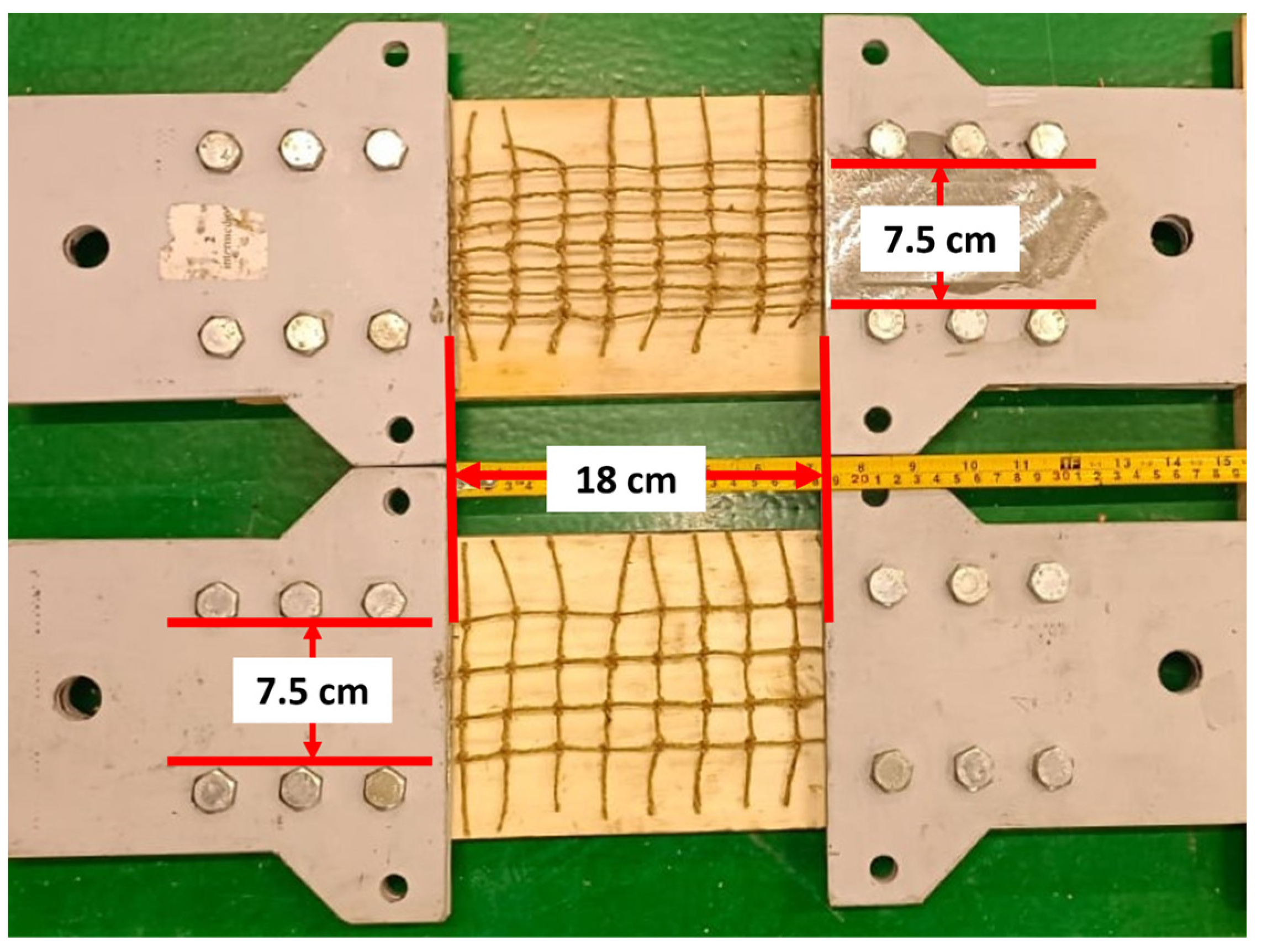
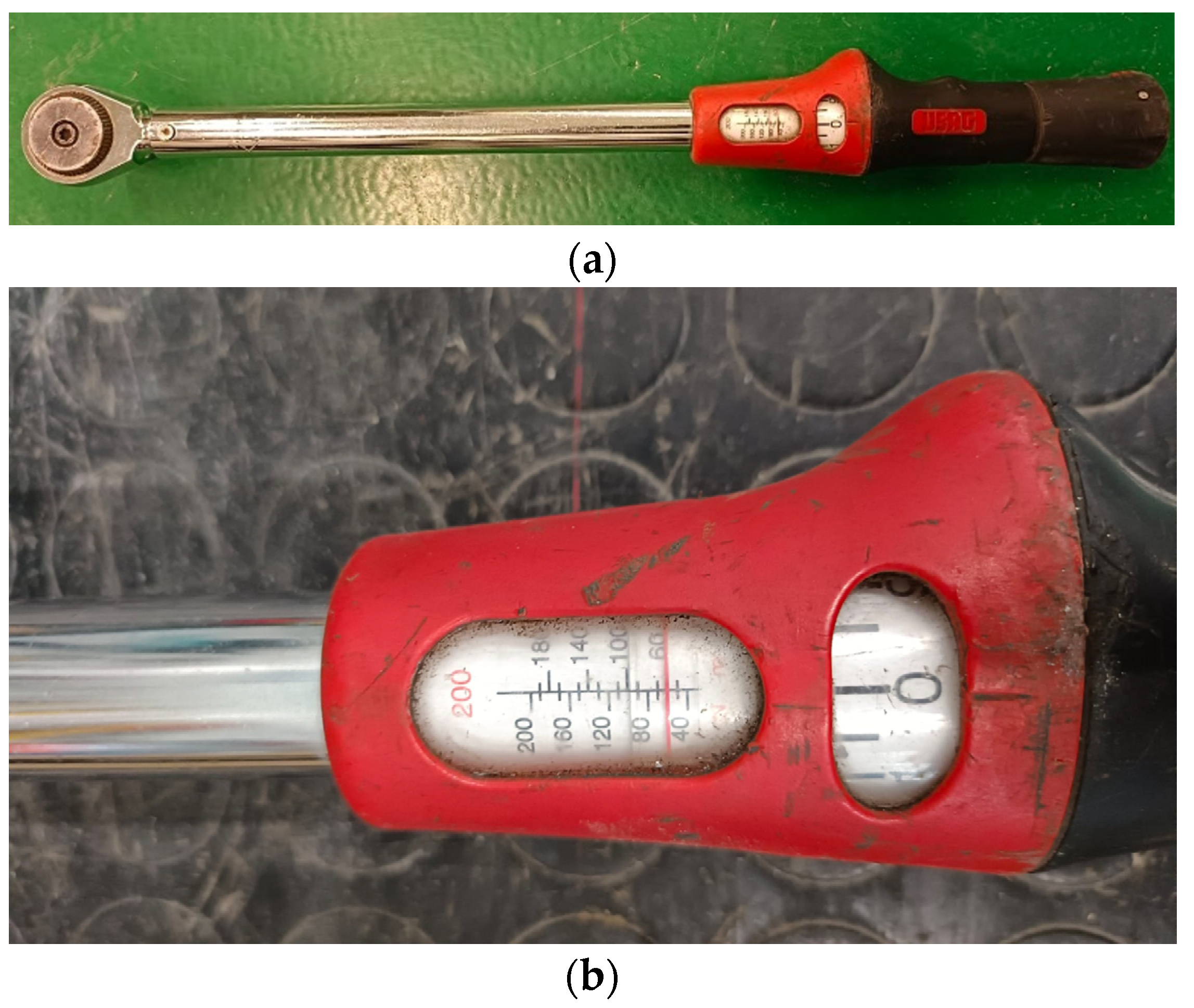
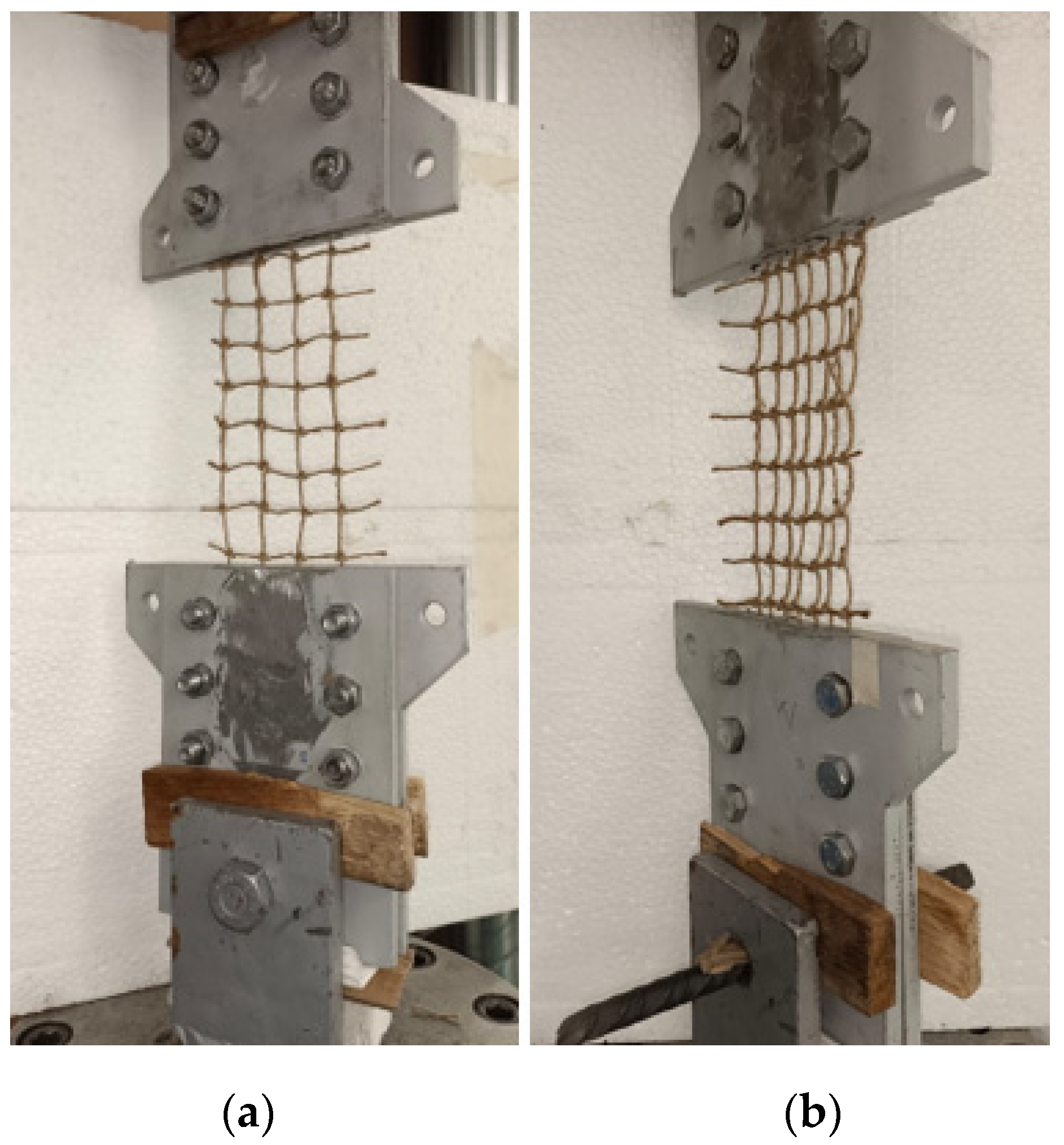
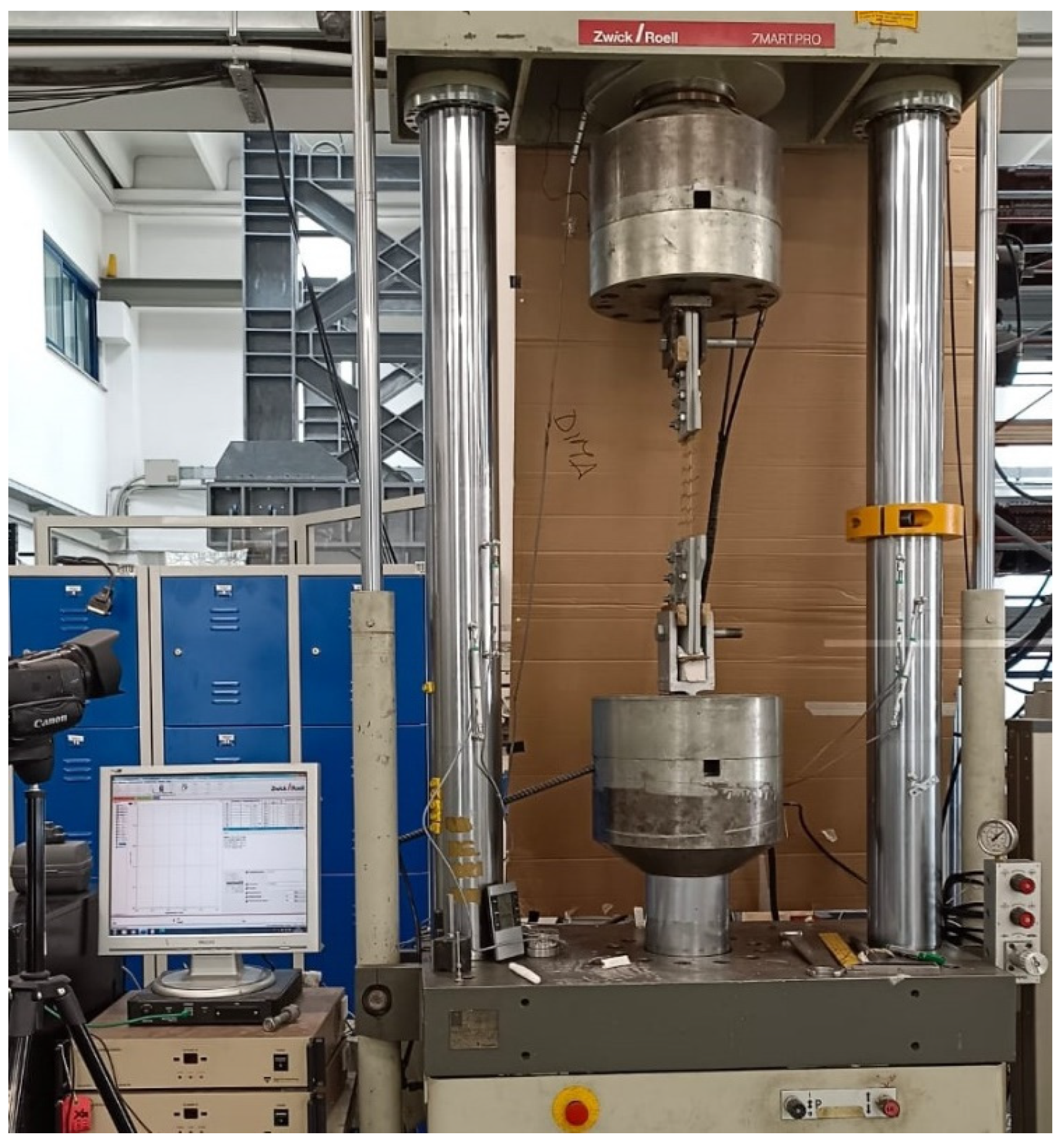


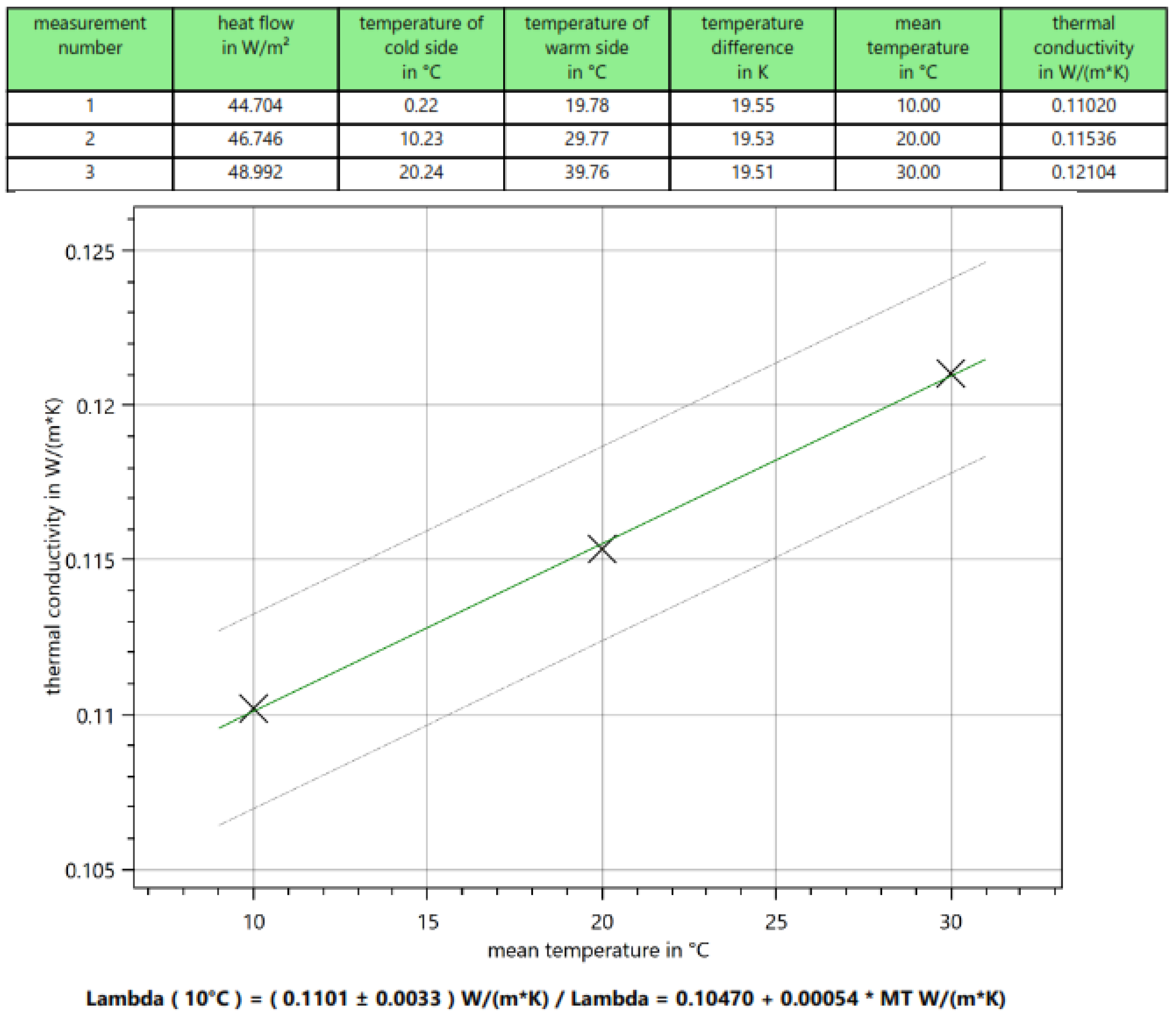
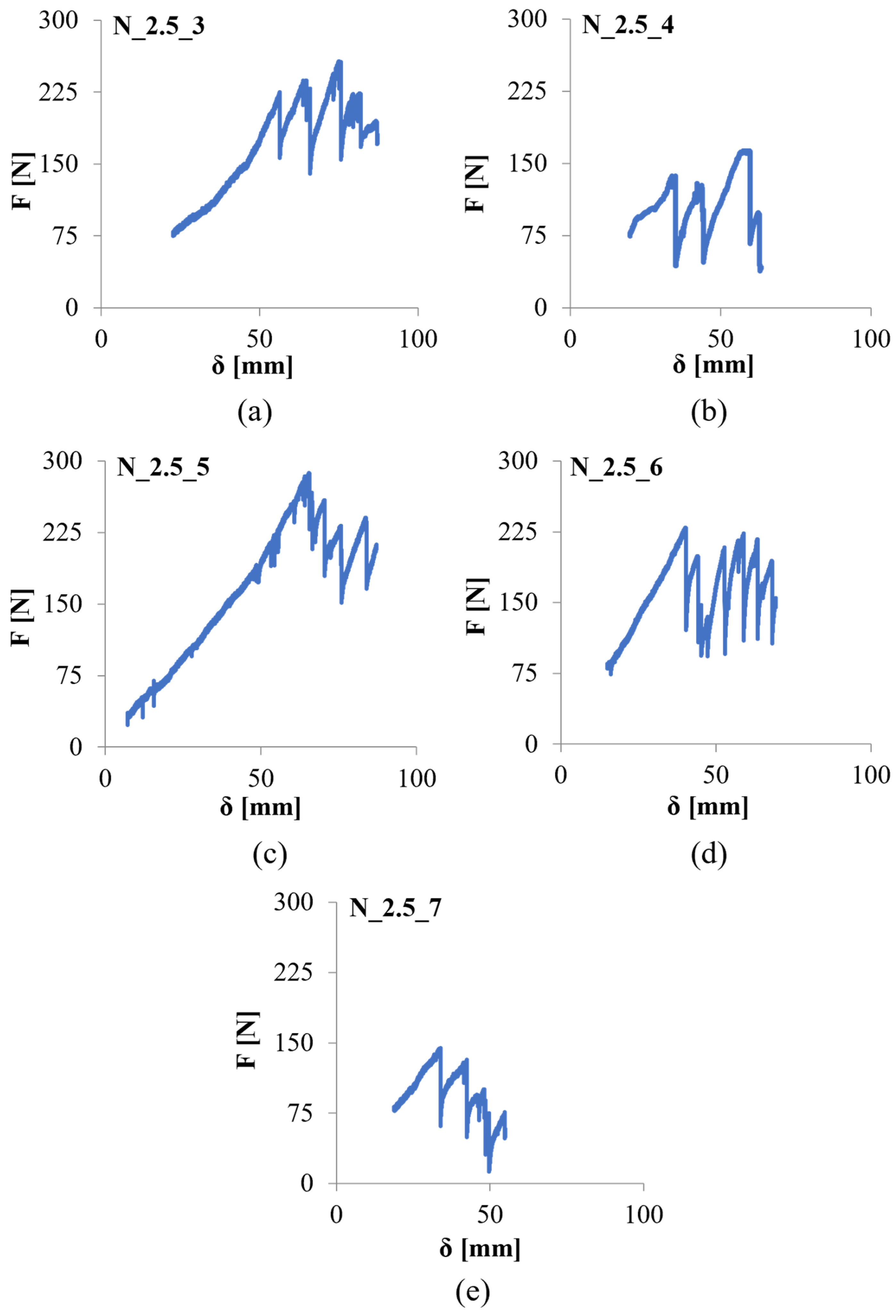
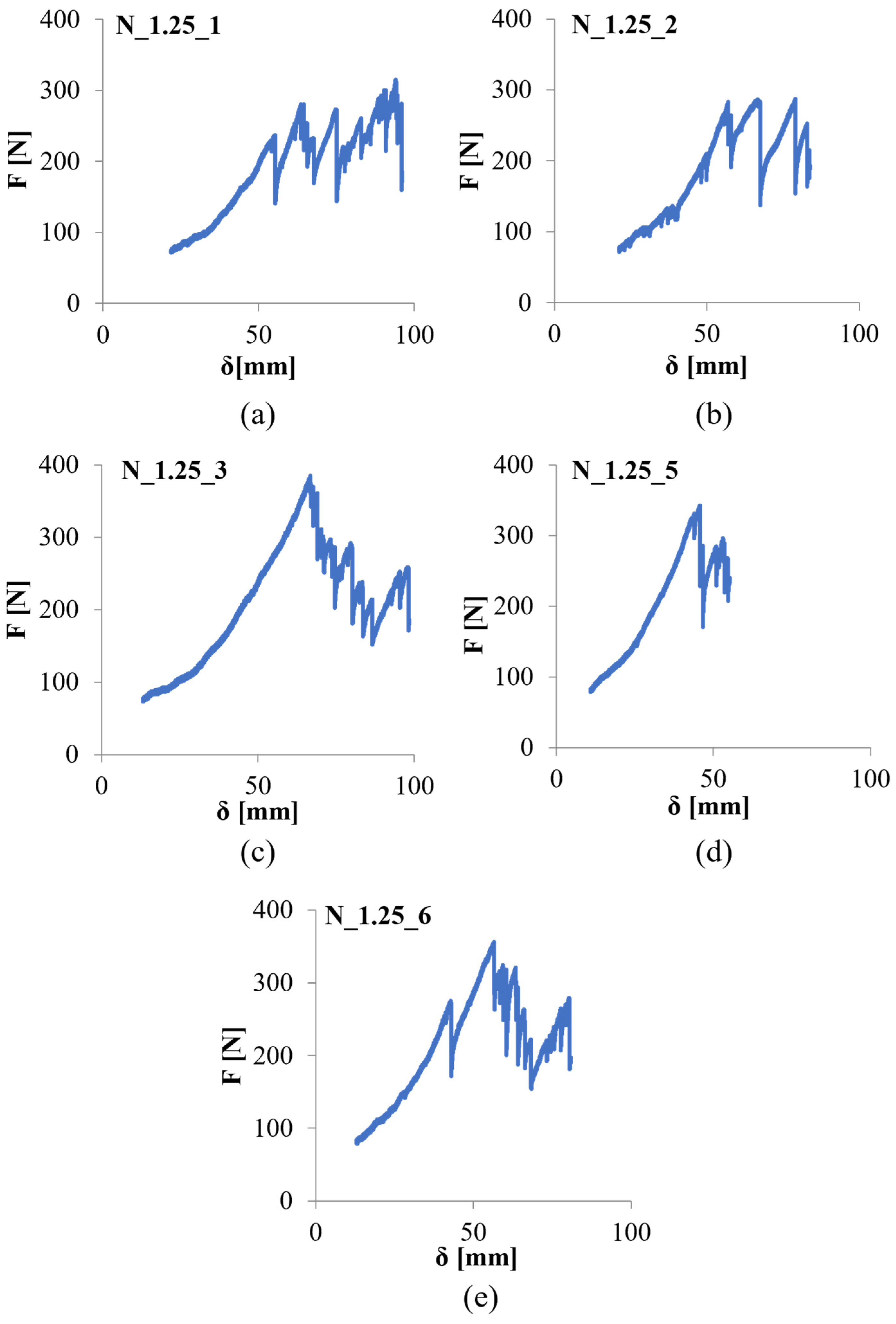

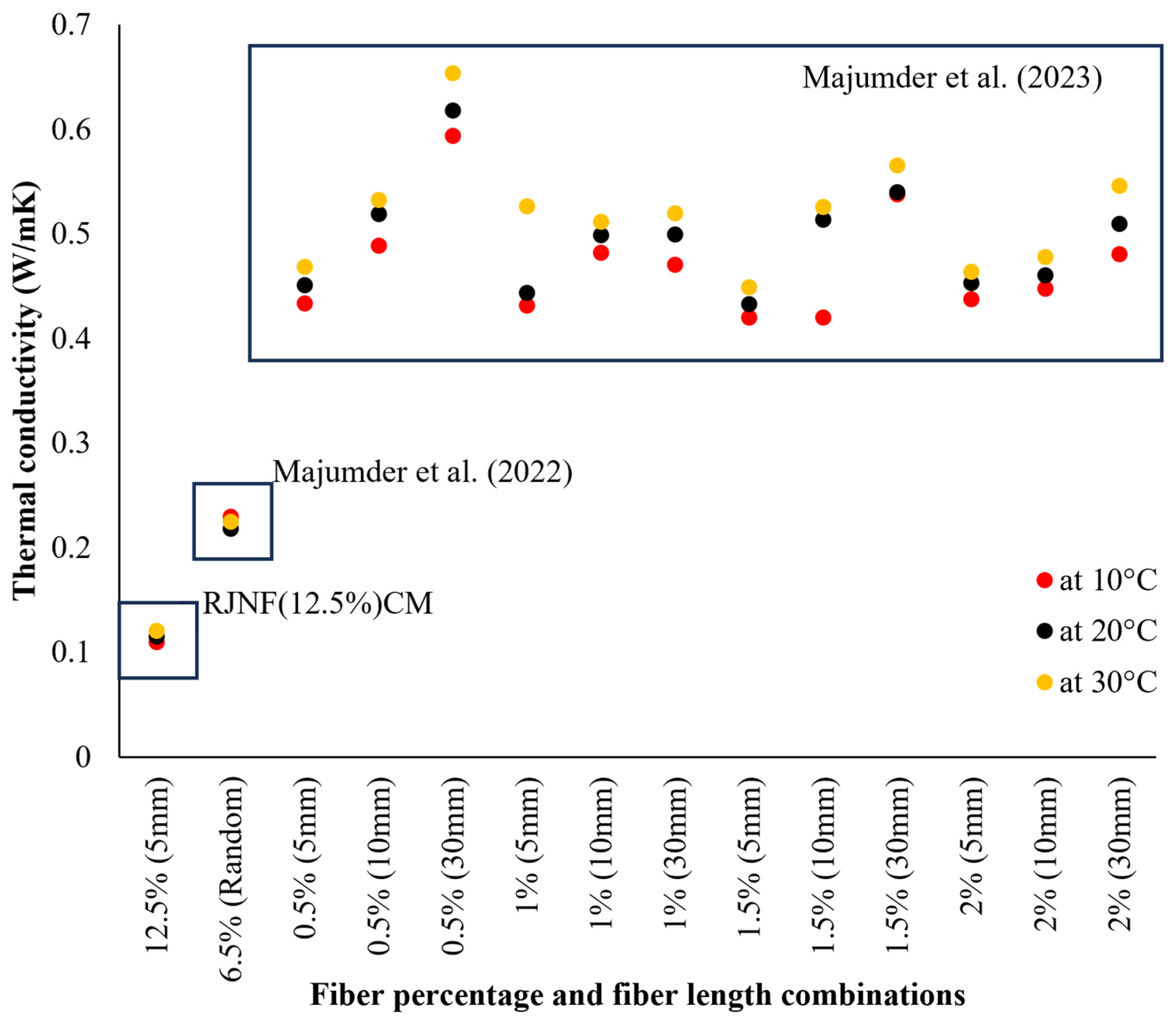
| Total Recycled Jute Net Fiber Used | Total Water Used for the Mixture |
|---|---|
| 12.5% of the dry mortar mass | 49.8% of the total mixture (mortar + fiber) mass |
| Measuring Intervals | min |
|---|---|
| Intermediate sampling time | 1 |
| Total measuring time | 300 |
| Sample Nomination | Max. Load | Max. Displacement | Strain Energy | Stiffness | ||||
|---|---|---|---|---|---|---|---|---|
| Mean | Co.V | Mean | Co.V | Mean | Co.V | Mean | Co.V | |
| N | % | mm | % | kN.mm | % | N/mm | % | |
| N_1.25 | 337.21 | 9.94 | 82.86 | 18.56 | 14.05 | 21.04 | 10.28 | 11.98 |
| N_2.5 | 217.23 | 24.82 | 72.46 | 17.82 | 8.76 | 39.14 | 7.57 | 20.22 |
| Sample | First Collapse Load | Maximum Load | Corresponding Displacement at Maximum Load |
|---|---|---|---|
| N | N | mm | |
| N_2.5_3 (Figure 10a) | 220.5 | 257.38 | 75.69 |
| N_2.5_4 (Figure 10b) | 136.00 | 167.48 | 37.4 |
| N_2.5_5 (Figure 10c) | 287.67 | 287.67 | 65.25 |
| N_2.5_6 (Figure 10d) | 229.42 | 229.42 | 40.14 |
| N_2.5_7 (Figure 10e) | 144.21 | 144.21 | 33.80 |
| Sample | First Collapse Load | Maximum Load | Corresponding Displacement at Maximum Load |
|---|---|---|---|
| N | N | mm | |
| N_1.25_1 (Figure 11a) | 236.50 | 314.40 | 94.21 |
| N_1.25_2 (Figure 11b) | 281.99 | 287.33 | 79.00 |
| N_1.25_3 (Figure 11c) | 384.69 | 384.69 | 66.65 |
| N_1.25_5 (Figure 11d) | 342.76 | 342.76 | 45.72 |
| N_1.25_6 (Figure 11e) | 271.84 | 356.09 | 56.20 |
| λ (W/mK) | ||||
|---|---|---|---|---|
| Tests Performed at | ||||
| Sample Nomenclature | 10 (°C) | 20 (°C) | 30 (°C) | Reference Thermal Conductivity Values of Samples with Different Combinations [Jute Fiber Percentages (with Respect to the Dry Mortar Mass) & Jute Fiber Lengths]. |
| RJNF(12.5%)CM (12% of recycled jute net fiber with respect to the dry mortar mass) | 0.110 (with Co.V. of 8.5%) | 0.115 (with Co.V. of 6.52%) | 0.121 (with Co.V. of 4.12%) | |
Disclaimer/Publisher’s Note: The statements, opinions and data contained in all publications are solely those of the individual author(s) and contributor(s) and not of MDPI and/or the editor(s). MDPI and/or the editor(s) disclaim responsibility for any injury to people or property resulting from any ideas, methods, instructions or products referred to in the content. |
© 2024 by the authors. Licensee MDPI, Basel, Switzerland. This article is an open access article distributed under the terms and conditions of the Creative Commons Attribution (CC BY) license (https://creativecommons.org/licenses/by/4.0/).
Share and Cite
Majumder, A.; Stochino, F.; Frattolillo, A.; Valdes, M.; Gatto, G.; Martinelli, E. Sustainable Retrofitting Solutions: Evaluating the Performance of Jute Fiber Nets and Composite Mortar in Natural Fiber Textile Reinforced Mortars. Sustainability 2024, 16, 1175. https://doi.org/10.3390/su16031175
Majumder A, Stochino F, Frattolillo A, Valdes M, Gatto G, Martinelli E. Sustainable Retrofitting Solutions: Evaluating the Performance of Jute Fiber Nets and Composite Mortar in Natural Fiber Textile Reinforced Mortars. Sustainability. 2024; 16(3):1175. https://doi.org/10.3390/su16031175
Chicago/Turabian StyleMajumder, Arnas, Flavio Stochino, Andrea Frattolillo, Monica Valdes, Gianluca Gatto, and Enzo Martinelli. 2024. "Sustainable Retrofitting Solutions: Evaluating the Performance of Jute Fiber Nets and Composite Mortar in Natural Fiber Textile Reinforced Mortars" Sustainability 16, no. 3: 1175. https://doi.org/10.3390/su16031175








